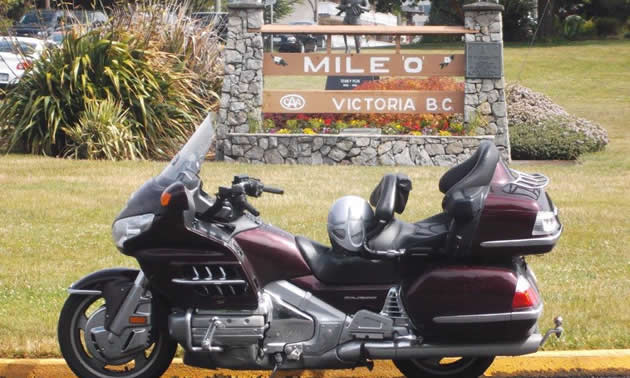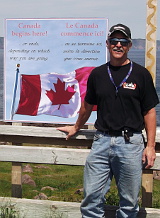Unbelievable! Eighteen thousand kilometres. After all the planning, I placed my message in a bottle in both the Pacific and Atlantic oceans and now I am back home safe and sound. In hindsight, it seems like it was over in a heartbeat.
The trip required a great deal of preparation. Right from the get-go, I needed to make sure my ride was up to the challenge. A big thank you goes out to Riverside Honda & Ski-Doo in St. Albert, Alberta, for tweaking my baby before I left. It performed without a hiccup.
The camaraderie of it all
I know what had attracted me to motorcycling many years ago as a young boy: my grandfather and a police Harley. If you ride, you know of the camaraderie as bikers wave when they pass each other on the highway, or when stopped, and they share their stories. Perhaps due to an unfulfilled bucket list item, you know of the mystique when out of nowhere strangers approach you to ask questions.
It didn’t take long for me to meet a fellow motorcyclist. On Day 1, after leaving Edmonton, Alberta, and heading southwest to Cranbrook and then Vancouver Island, British Columbia, I was fuelling up in Rocky Mountain House, Alberta, and a stranger approached me. He was intrigued with my goal and shared his wish to ride coast to coast. We shared many memories including our boyhoods and our love of motorcycles.
That night, I tented in Cranbrook and met up with the folks at RidersWest magazine at 8 a.m. I had been anxious to get going as I left town, and little did I know I would soon be riding past an ice-covered lake and through fresh snow falling on the roadway in the mountains.
The ferry ride to Vancouver Island was pleasant and was when I had my first smell of the salt air coming off the ocean. Thankfully, after the mountains, the City of Victoria treated me to sun and warm temperatures. I made my way to Beacon Hill Park for a photo op: the location of the Mile Marker 0 for the Trans-Canada Highway.
At Mile 0 there were two gals taking pictures, and we struck up a conversation. Coincidentally, they were vacationing and had flown from their home in St. John’s, Newfoundland, and were familiar with Mile 0 at Cape Spear, Newfoundland. They expressed envy of my adventure and wished me luck.
First message released
After visiting my daughter and new granddaughter, I headed “up island” to Tofino with my son-in-law Kirb on the back. We had my message in a bottle and we went in search of some open ocean to release the message.
We tented in the Pacific Rim National Park, where it proceeded to pour rain all night long. Fortunately, the rain stopped as we were packing up in the morning. We found an accessible beach with the tide out and we walked towards the Pacific Ocean. Innocently enough, we unknowingly stumbled onto Frank Island, which is only accessible during low tide. We met a fellow on the island whose family has lived there for years and he explained to us that the area is a private island. My mission to release my message in a bottle was explained to him, and he steered us towards an area where he felt the tides would embrace my bottle and take it out into the depths of the Pacific. The message was released and seen bobbing in the distance as we left.
Eastward ho!
After leaving Vancouver Island, I headed east on the Sea-to-Sky Highway, winding through Whistler, Pemberton and Lillooet and then easterly on the Yellowhead Highway through Jasper, Alberta. In search of the roads less travelled, I continued northeast passing Cold Lake, Alberta, and headed through Meadow Lake, Saskatchewan, and into northern Manitoba. I made small talk with countless motorists, gas station attendants and even construction flag people during the peacefulness of these roads less travelled.
As I was heading southeast out of northern Manitoba, Lake Winnipeg in all its vastness was on my left. I stopped for gas at West Hawk Lake, Manitoba, and met another biker fuelling. We chatted about our adventures. This fellow, whose name was Dean, had Newfoundland on his biker bucket list but something had come up and that goal was on hold. We rode together as far as Kenora, Ontario, where we parted ways with merely a wave.
The next day, after a restful tent night, I stopped for fuel in Ignace, Ontario. I inadvertently began small talk with a motorist about his dogs, which were hanging out the window of his car, and then made my way inside the gas station. The fellow followed me inside and proceeded to explain: he had just worked on two large projects in Alberta and he recognized me. He had been heading home to Richibucto, New Brunswick, on vacation.
Remembering Terry Fox
I stopped at the Terry Fox memorial just east of Thunder Bay, Ontario. Terry had been a young man who lost a leg to cancer. In 1980, as a fundraiser for cancer research, Terry endeavoured to run a marathon a day, from coast to coast, beginning in St. John’s, Newfoundland. My home province, Prince Edward Island, was a part of Terry’s run, and the local media encouraged people to get involved. I ran beside Terry on the Trans-Canada Highway outside of Charlottetown. Sadly, Terry lost his battle with cancer near Thunder Bay.
I stopped on Prince Edward Island and grabbed a backseat passenger for my trip to Newfoundland—Bruce, my 80-years-young stepfather—and we headed to North Sydney, Nova Scotia, to catch the car ferry. As ferry traffic lined up, we were approached by many bikers and non-bikers, curious about our trip.
A fellow from the United States approached me and commented on a T-shirt I had been wearing, highlighting “Deals Gap” in North Carolina. We had a long chat, and he estimated that he had logged over 804,672 kilometres of riding, and he too had been to Deals Gap. As a twist, he had been leading a convoy of American tourists driving motorhomes to Newfoundland.
We also chatted with a group of ATVers who were at the head of the line, waiting for the ferry with their quads. I chatted with a grandfather and grandson who would ride their quads off the ferry and then explore and camp with their quads on many kilometres of abandoned railway lines.
Riding the Rock
After arriving on the Rock, our first goal was to head to the east side of the Island to Cape Spear, reportedly the most easterly tract of land in Canada. We arrived at Cape Spear to the sight of the vast Atlantic Ocean, large icebergs off in the distance and whales breaking the surface and entertaining those aboard whale-watching boats.
Again, we chatted with many folks enjoying the same sights as us, some bikers, some not. One tourist loaned me his high-powered binoculars to allow me to ogle over a huge iceberg. We chatted at length with two bikers, riding adventure bikes. It turned out they were from southern Alberta and members of the Alberta Dual Sport riding group.
My second message in a bottle was set adrift at Cape Spear, and Bruce and I set off in search of more adventure. Snaking our way around many peninsulas, we meandered along the northeast coast. Just east of Musgrave Harbour, we noted several RVs set up for the night just off the highway on a strip of grassy land. It turned out this group of locals regularly use this strip of land for camping. We were welcomed and set up our tent with its door within spitting distance of the Atlantic Ocean. The Newfoundlanders are notoriously friendly, and prior to sundown we wandered around and chatted with many. Many tips and suggestions were offered on roads we should take.
After all these years of riding, I still find it a mystery—the intrigue of strangers towards bikers.
Stay tuned for my next article, which will include tips on some great roads to explore.
« Back to Motorcycle Zone »

Comments